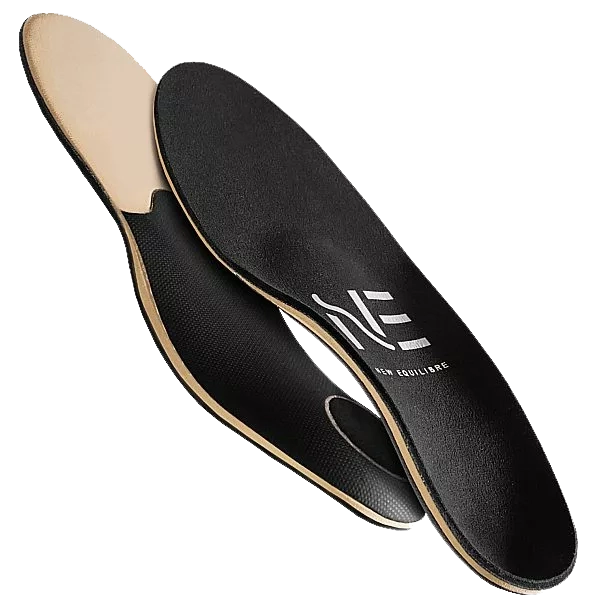Calcaneal spur
the complete guide
- Published on
- By New Equilibre
SUMMARY :
- What is a calcaneal spur?
- What are the symptoms of calcaneal spur?
- How long does a calcaneal spur last?
- Can you walk with a calcaneal spur?
- Insoles for calcaneal spur
- What causes calcaneal spurs?
- What medication should I take to relieve calcaneal spur?
- How to relieve a calcaneal spur with Grandma's remedies?
- What shoes should I wear if I have a calcaneal spur?
Heel spur is a painful condition affecting the heel, often associated with inflammation of the plantar fascia, known as plantar fasciitis. Calcaneal spur, also known as Lenoir's spur or calcaneal osteophyte, is a common pathology that can lead to intense heel pain, making walking and daily activities difficult.
Symptoms of heel spur can range from mild to stabbing, persistent pain, aggravated by walking or running. This pain is often felt in the heel area, particularly when taking your first steps in the morning or after a prolonged period of rest. The onset of heel spurs is often linked to factors such as excess weight, intense physical activity or unsuitable footwear.

In this article, we'll explore in detail all aspects of heel spur, from its causes and symptoms to its treatment options, including tips for prevention and pain management. We'll also look at the various non-surgical treatments available, such as the use of orthotics, physical therapy and anti-inflammatories, as well as surgical options for the most severe cases.
Whether you've already experienced heel spur or simply want to know more about the condition, this guide is designed to provide you with all the information you need to understand, manage and effectively treat heel spur.
What is a calcaneal spur?
Calcaneal spur is a thorn-like bony growth that can form on the calcaneus, the heel bone. This condition usually results from irritation of the plantar fascia, a band of tendinous tissue located under the sole of the foot, hence its other name, plantar fasciitis. Calcaneal spur can also be triggered by overuse of the Achilles tendon, which encourages the development of this bony growth on the upper part of the calcaneus. The persistence of overuse exerts tension on the periosteum, leading to the formation of calluses and bone calcifications. This is commonly known as Calcaneal Spur. Although not usually visible to the naked eye, it can be diagnosed by X-ray.
There are two types of Clacaneal Spur :
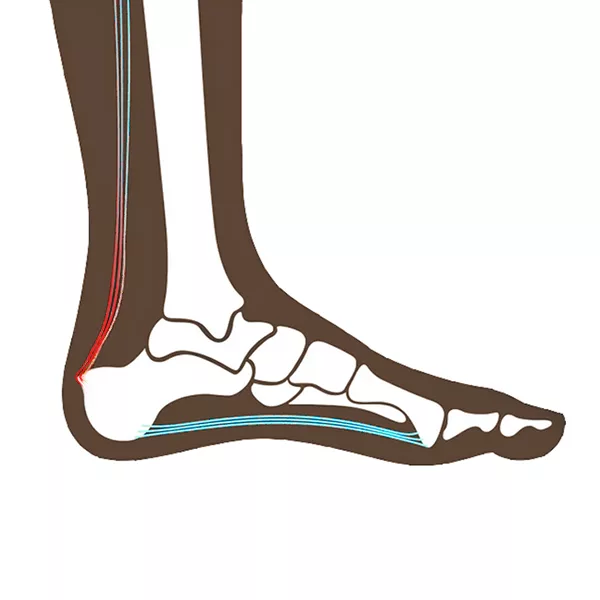
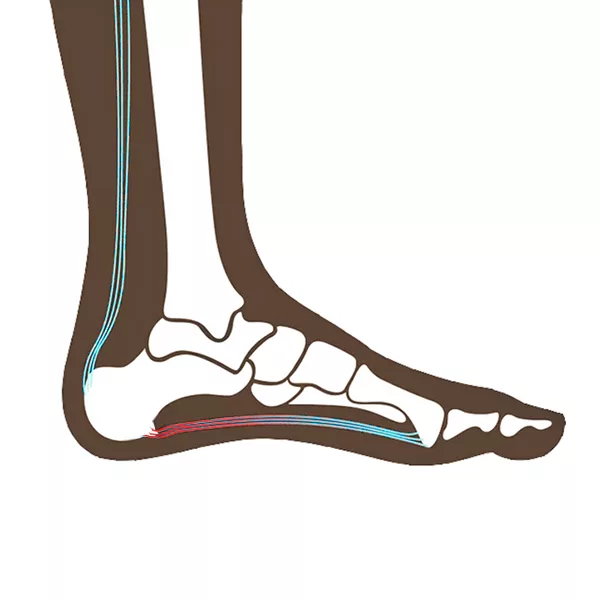
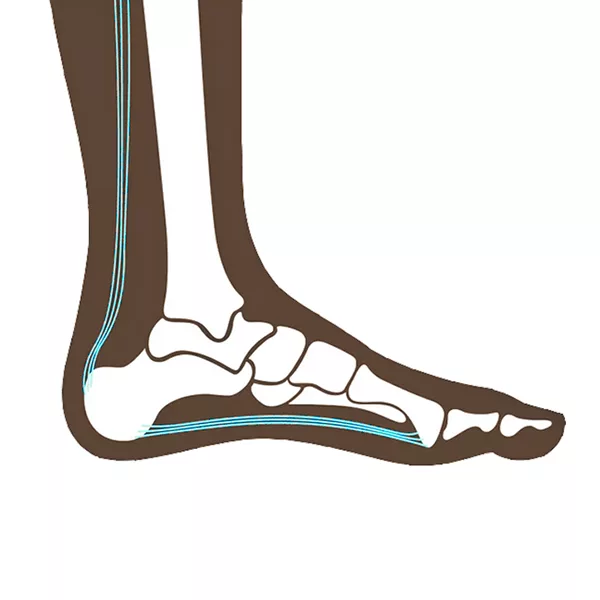
Posterior calcaneal spine (cranial calcaneal spine) : In this case, the bony outgrowth forms at the base of the calcaneus, at the Achilles tendon. Pain is felt under the heel. Posterior calcaneal spur occurs when the Achilles tendon is overworked.
Inferior heel spur (plantar heel spur) : The bony deformity appears here on the underside of the heel. The inferior heel spur is created when the plantar fascia is overworked.
What are the symptoms of calcaneal spur?
When you set out to do something, you may feel a stabbing pain in your heel. Mornings bring their share of "cold" pains, especially when you take your first steps after waking up. These pains are not limited to the foot, but can also radiate down the leg.
As a result of the inflammatory reaction, the calcaneal spur may swell, creating a sensation of heat in the heel area. Sometimes, a slight elevation may even be visible or palpable in the heel. Although heel spurs can often go unnoticed due to the absence of obvious symptoms, some people do suffer from them. At one time, heel spurs were often treated surgically, with little success in alleviating long-term pain. However, the good news is that surgery is only necessary in exceptional cases. On the other hand, there are ways to alleviate the discomfort of heel spurs with the tips below.
How long does a calcaneal spur last?
The duration of this pathology can vary and depends on several factors.
Severity of condition : Calcaneal spurs can vary in size and severity. Some may be smaller and less symptomatic, while others may be larger and more painful. Larger spines or more severe cases of plantar fasciitis may require more intensive treatment and therefore take longer to heal.
Comorbidities: Underlying medical conditions such as obesity, arthritis or other health problems can affect recovery from this condition. These conditions can aggravate symptoms and prolong recovery time.
Treatment compliance : Patient compliance with recommended treatment can also play an important role in the length of recovery. Patients who rigorously follow their healthcare professional's recommendations, including self-care measures at home and follow-up appointments, are more likely to see faster improvement in their symptoms.
Can you walk with a calcaneal spur?
It is perfectly possible to walk despite the presence of a calcaneal spur. Pain is generally felt in the morning and evening, although it may occur less frequently during the day. The frequency and intensity of pain will depend on the stage of the pathology. Orthopedic insoles are the most effective, long-term solution for ensuring pain-free walking.
Wearing orthotics with a calcaneal spur
The orthopedic insoles can relieve heel spur inflammation by relieving pressure on the heel. Thermoformed insoles supporting the medial, lateral and anterior plantar arches evenly distribute the foot's support zones and relieve pressure on the hindfoot. These supports relieve pressure on your musculo-tendinous system, rapidly reducing the inflammation caused by this pathology. The New Equilibre Insoles are designed to effectively relieve this pathology. Equipped with cushioning and comfort materials, they also provide excellent comfort and long-lasting pain relief. Orthotics should be worn daily to prevent the inflammation from returning. Wearing orthotics is the most effective treatment for overcoming Lenoirv's spur pain quickly and over the long term.
Orthopedic insoles for calcaneal spurs :
At New Equilibre, we have developed an insole model specifically for the treatment of heel spurs thanks to over 30 years of in-office expertise with thousands of patients.
Our insoles for calcaneal spurs are designed with high-tech, top-of-the-range materials to provide you with unrivalled comfort in your shoes. The different layers of material meet precise criteria in terms of density, shock absorption and load distribution.
What's more, their thermoformed shape provides perfect support for your entire foot, supporting your medial, lateral and anti-erosive plantar arches, thus relieving pressure on your entire musculo-tendinous system. This helps to relieve inflammation very quickly, totally relieving the excessive tension undesirably exerted on your plantar muscles. What's more, the shape of New Equilibre insoles increases your weight-bearing surface to 100%, which also plays a part in distributing the loads on your foot while rebalancing your posture correctly.
New Equilibre insoles have been tested and approved by thousands of users. Their effectiveness is clinically proven. It's easy to order your insoles exclusively from our online store, and regain the comfort your feet deserve.
Free delivery to metropolitan France, within 2 working days. Free returns within 14 days.
What causes calcaneal spurs?
Inadequate postural habits and excessive strain when standing, walking or running are the main sources of heel spurs.
Inflammation of the plantar fascia or, more rarely, the Achilles tendon:
When you subject the tendons in your feet to excessive and prolonged strain due to long periods of standing or sporting activity, non-physiological tensions can emerge. In fact, micro-tears or inflammations can also develop in the heel area. In fact, micro-tears or inflammations can also develop in the heel. This is known as plantar fasciitis. So, in response to this incorrect posture, your body adapts by accumulating calcium at the base of the tendons under increased pressure. This accumulation is designed to strengthen the calcaneus and restore the natural tension balance. However, this bony outgrowth is not responsible for the pain. This is the result of increased tension on the periosteum and, in advanced stages, chronic inflammation of the plantar fascia. More rarely, heel pain can result from increased tension and inflammation of the Achilles tendon.
Lack of mobility in the sacroiliac joint:
The sacroiliac joint connects the sacrum to the ilium, the back of the pelvis to the spine. Although it may seem surprising, reduced pelvic mobility can lead to heel problems. Indeed, the often unilateral lack of mobility of the sacroiliac joint can lead to misalignment of the pelvis. Altered tensions along the posterior myofascial chain create a length imbalance between the legs. As a result, weight is distributed unevenly across your feet. As a result, the calf and foot muscles are overloaded on the side with the greatest stress. The heel adopts an unnatural position, over-tensioning the plantar fascia and causing inflammation.Translated with www.DeepL.com/Translator (free version)
What medication should I take to relieve calcaneal spur?
In the event of heel spur, it is advisable to consult a podiatrist/orthopedist to obtain a precise diagnosis and a treatment adapted to your situation. Several medical solutions can be considered:
Anti-inflammatories and analgesics
The doctor may prescribe non-steroidal anti-inflammatory drugs (NSAIDs) such as ibuprofen to reduce inflammation and relieve pain. Analgesics such as paracetamol can also be used to reduce pain.
Corticosteroid injections
In some cases, corticosteroid injections can be administered directly into the affected area to relieve inflammation and pain. This treatment must be carried out with caution and under medical supervision, as it can potentially lead to complications.
How to relieve a calcaneal spur with Grandma's remedies?
In addition to medical treatment, there are a number of natural methods that can be used to quickly relieve and heal heel spurs. First and foremost, it's important to rest the affected foot, so as not to exacerbate the inflammation.
Hot and cold therapy
- Cold: Applying cold to the painful area can help reduce inflammation and relieve pain. Vous pouvez utiliser des glaçons enveloppés dans un linge propre ou un sac de gel réfrigérant. Appliquez le froid pendant 15 à 20 minutes, plusieurs fois par jour.
- Foot bath: Immersing your foot in a warm water bath with added Epsom salt relaxes muscles and promotes blood circulation in the affected area. Repeat this treatment daily until the pain improves.
Muscle stretching
Regular stretching can help improve the flexibility and resistance of foot muscles and ligaments. Here are a few exercises you can do at home:
- Calf stretch: stand facing a wall, place your hands against the wall and move one foot in front of the other. Keep your back heel on the ground and push gently towards the wall.
- Arch stretch: Sit on a chair and place a tennis ball under the arch of your foot. Roll the ball under your foot for a few minutes.
- Toe stretch: Sit on a chair and place your affected foot on the other knee. Gently pull the toes towards you to stretch the arch ligaments.
Foot massages
Evidence shows that self-massage of the plantar fascia and calf muscles can improve mobility and reduce muscle tension. So, when self-massaging the plantar fascia, pay attention to a few key points: work close to the heel spur, apply light pressure in the painful area. Don't forget to pay attention to the mobility of the sacroiliac joint. These simple measures can help relieve heel spur symptoms while you rest.
These treatments do help to alleviate pain, but only in the short term. They won't provide total relief from this pathology, which will keep resurfacing without effective treatment to support your foot. That's why daily orthopedic inserts remain the best long-term treatment.
What shoes should I wear if I have a calcaneal spur?
Choose your footwear wisely and vary your sports shoes regularly. Indeed, worn-out shoes and those with a pronounced arch (a significant difference in height between the heel and the forefoot) can encourage the development of inflammation. We recommend sneaker-type shoes, with a large footbed to ensure greater comfort. What's more, this type of shoe is usually fitted with removable insoles, which can be removed and replaced with comfortable orthopedic insoles adapted to your pathology. All that's left for you to do is fit New Equilibre orthopedic insoles, which provide effective pain relief thanks to their shock-absorbing materials and good arch and muscle support structure.
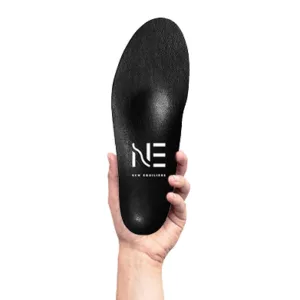
New Equilibre
Healthcare professionals specializing in the manufacture of orthopedic insoles for over 30 years. Clinically proven expertise with thousands of New Equilibre users and patients in orthopedic practices.

